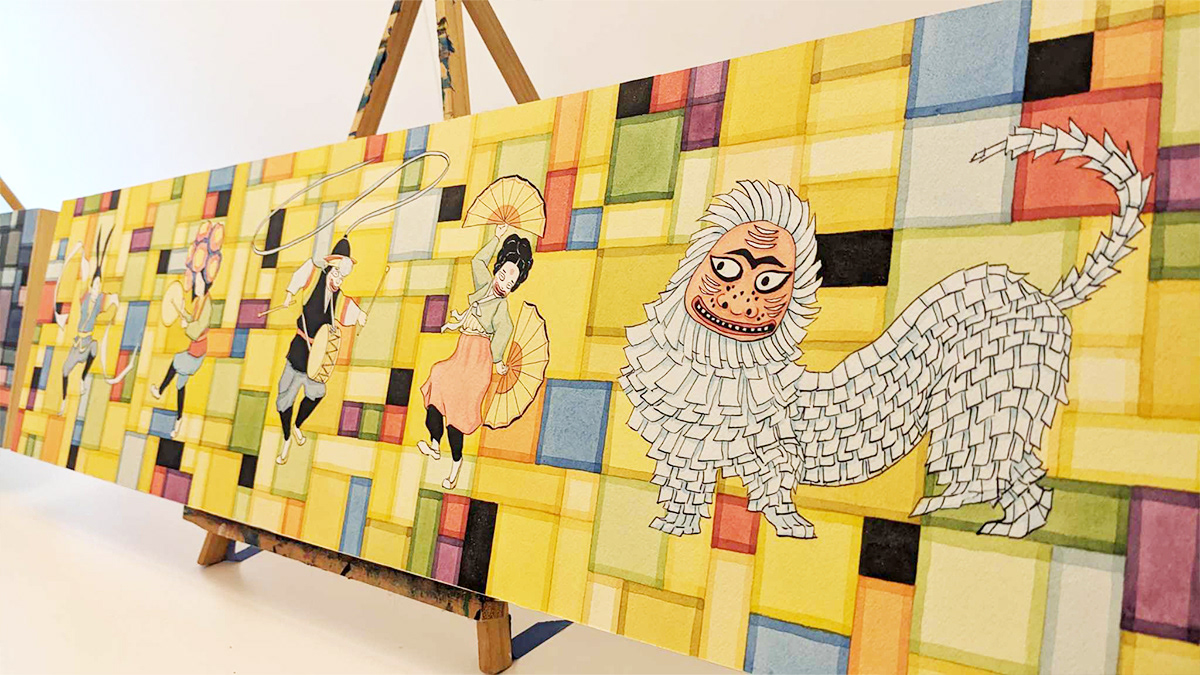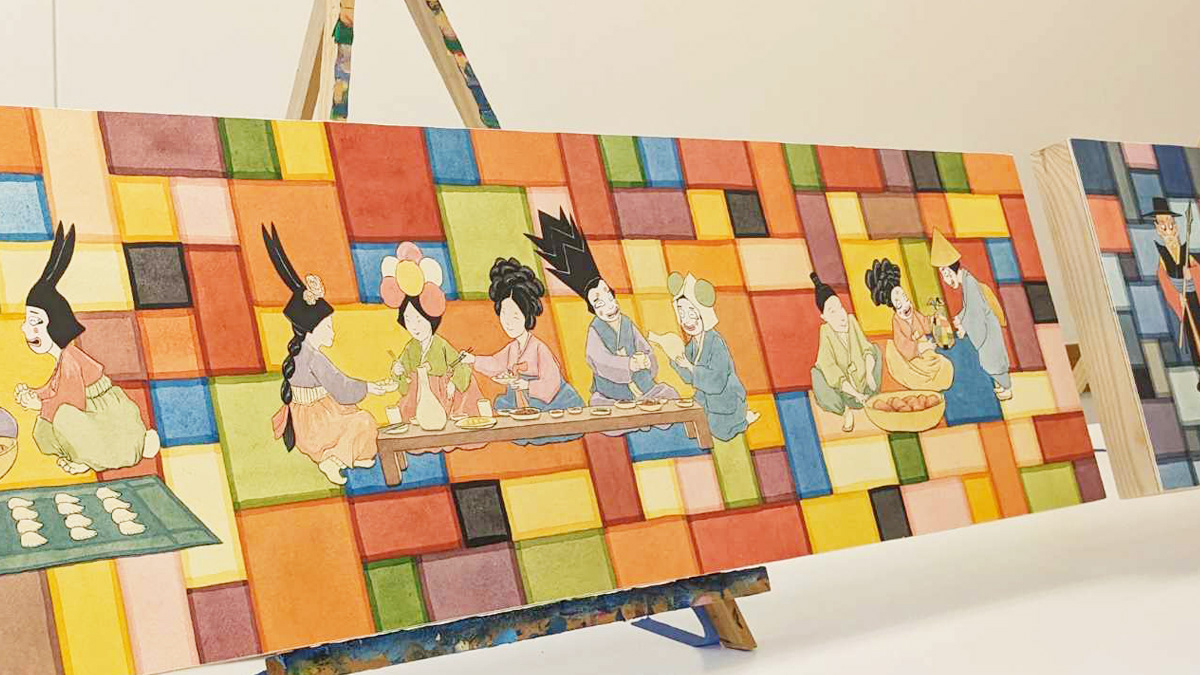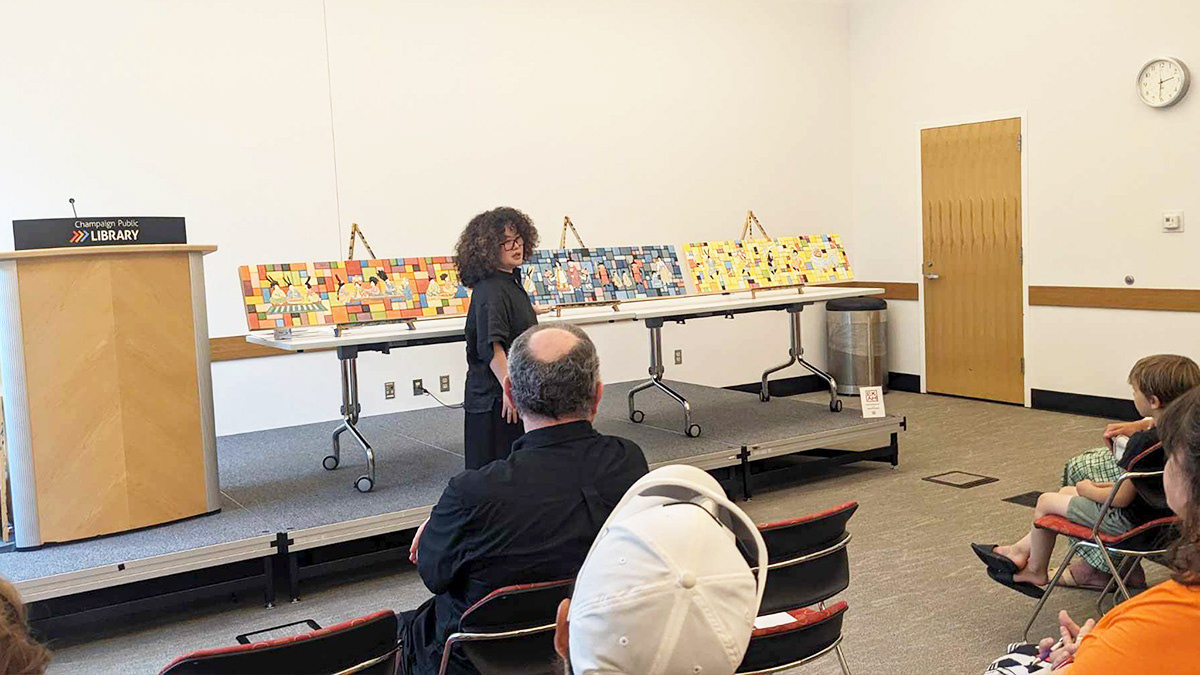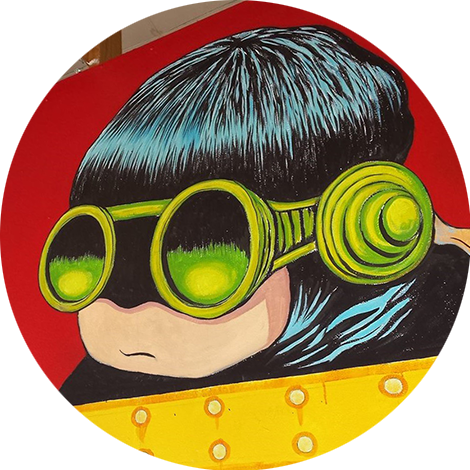Jeong, Han, & Heung (Heart, Regret, & Joy)
Watercolor & Ink on paper mounted on cradled wood panels.
48" x 36" (122 cm x 91.4 cm)
48 in. x 12 in. (122 cm x 30.5 cm) each panel
Watercolor & Ink on paper mounted on cradled wood panels.
48" x 36" (122 cm x 91.4 cm)
48 in. x 12 in. (122 cm x 30.5 cm) each panel
The project was in part funded by Community Arts Access Grants from 40 North on behalf of the Illinois Arts Council Agency and the National Endowment for the Arts.
The triptych is an exploration of three of many essences, or traits, of collective emotions which characterize the artist’s South Korean cultural roots. Each scroll panel depicts and illustrates corresponding emotion in the manner of the artist's interpretation.
I am a Korean-American immigrant who has faced challenges to define my identity as an artist, individual, and as a member of the society in which I live in. My worldviews are shaped by growing up in a multicultural environment with its core being Korean at its root. The project hopes to achieve visual expression of what these essences are. The title suggests the three main emotions, but these words do not exist in the English language. The title is an imperfect translation that approximates the essence of the said feelings.
Jeong / Heart (정): Jeong can be found between family, friends, lovers, and even strangers. Jeong can be love, tenderness, sharing, caring, kindness, generosity, or friendship. When a mother lovingly packs a lunch for her child, one would say the ‘lunch is packed with jeong.’ The child who brings that lunch and shares it with a classmate is jeong. Almost all dishes in a family meal are shared in Korea, even at restaurants. Even in modern-day Korea, it is common to run into a group of strangers at a sports game or on a hike in a mountain who would offer their snacks to share with you. These strangers ‘have a lot of jeong’ and share their food with strangers without food. A life-long friends have a lot of jeong between them. Their jeong will shape their friendship and how they share their lives with each other.
Han / Regret (한): Han can be regret, deep sorrow, unfulfilled dream, unrevenged injustice, or unresolved heartbreak. Korea has suffered much han its history. The country was invaded for centuries, then occupied for 35 years in the beginning of the 20th century by Japan. Korea was then divided after a civil war between North and South. The country was in ruins and lived in extreme poverty. There was han for being poor with nothing left. The collective drive, or han, to succeed and surpass its once occupier was great. There is han, a deep sorrow and longing, for family members who were never to be seen again because of the division of North and South. There was han from mothers and fathers who couldn’t provide for their children and send them to college. There was han from those who couldn’t repay the sacrifices their parents made to put them to college. There was han from lovers who were forced to separate and marry another through an arranged marriage. When one never has the chance to tell a loved one how much one loves them before they die, it becomes han. Many traditional Korean folk songs are full of han and heart breaks.
Heung / Joy (흥): Heung is something you have when you can enjoy a joyous moment and have a great time. Heung is an ability to party and celebrate. There is a lot of heung when a group of people can spontaneously dance and sing together. One may hum songs, sing out loud, and dance because one has a lot of heung. Many around the world often posit that K-pop is manufactured content to woo the international audiences. This could not be further from the truth. K-pop is a result of an abundance of heung in the Korean people. The Koreans have a lot of heung, and they are proud to set them apart from the more reserved neighboring countries.
Personal background story for the project and its purpose:
Many Korean-American communities spent decades being invisible by choice, often out of necessity to stay out of conflict and not bother with the status quo. The Korean communities did not bother to capture the hearts of mainstream America with their equivalent of General Tso’s Chicken, Teriyaki, or Pad Thai. Kimchi was not something people ordered as a takeout on a Tuesday night, and it was assumed that no one would eat it except for the Koreans. As a result of the Korean immigrant communities’ self-imposed cultural isolation, an average non-Korean person could not define the characteristics of the Korean culture.
Fast forward to 2020, one witnessed a second Hallyu or the Korean Wave. The first wave arrived in various parts of Asia in the early 1990s after South Korea ended its authoritarian-military ruling of its government. The second Wave came at the heart of the 2020 pandemic when people around the world were glued to YouTube and Netflix during social isolation. An explosion of labels in the most positive light - K-drama, K-films, K-food, K-beauty, K-pop, and so on. I have never known such a time living in the U.S. when Korean culture entered so much of the mainstream conscience. This happened simultaneously as social media outlets were plastered with #StopAsianHate. There was a sense of euphoria, confusion, and anxiety all at the same time.
Although it may be impossible to detach kimchi from the Korean culture, there are deeper, inner feelings that persist in the collective consciousness of the Korean people. The three essences can offer a glimpse into the people whose country of origin that was once called the Hermit Kingdom. With the advent of growing Hallyu around the world and the growing multicultural communities in the Champaign-Urbana area, I hope to share what Korean immigrant communities can bring culturally and artistically through this project.
I am a Korean-American immigrant who has faced challenges to define my identity as an artist, individual, and as a member of the society in which I live in. My worldviews are shaped by growing up in a multicultural environment with its core being Korean at its root. The project hopes to achieve visual expression of what these essences are. The title suggests the three main emotions, but these words do not exist in the English language. The title is an imperfect translation that approximates the essence of the said feelings.
Jeong / Heart (정): Jeong can be found between family, friends, lovers, and even strangers. Jeong can be love, tenderness, sharing, caring, kindness, generosity, or friendship. When a mother lovingly packs a lunch for her child, one would say the ‘lunch is packed with jeong.’ The child who brings that lunch and shares it with a classmate is jeong. Almost all dishes in a family meal are shared in Korea, even at restaurants. Even in modern-day Korea, it is common to run into a group of strangers at a sports game or on a hike in a mountain who would offer their snacks to share with you. These strangers ‘have a lot of jeong’ and share their food with strangers without food. A life-long friends have a lot of jeong between them. Their jeong will shape their friendship and how they share their lives with each other.
Han / Regret (한): Han can be regret, deep sorrow, unfulfilled dream, unrevenged injustice, or unresolved heartbreak. Korea has suffered much han its history. The country was invaded for centuries, then occupied for 35 years in the beginning of the 20th century by Japan. Korea was then divided after a civil war between North and South. The country was in ruins and lived in extreme poverty. There was han for being poor with nothing left. The collective drive, or han, to succeed and surpass its once occupier was great. There is han, a deep sorrow and longing, for family members who were never to be seen again because of the division of North and South. There was han from mothers and fathers who couldn’t provide for their children and send them to college. There was han from those who couldn’t repay the sacrifices their parents made to put them to college. There was han from lovers who were forced to separate and marry another through an arranged marriage. When one never has the chance to tell a loved one how much one loves them before they die, it becomes han. Many traditional Korean folk songs are full of han and heart breaks.
Heung / Joy (흥): Heung is something you have when you can enjoy a joyous moment and have a great time. Heung is an ability to party and celebrate. There is a lot of heung when a group of people can spontaneously dance and sing together. One may hum songs, sing out loud, and dance because one has a lot of heung. Many around the world often posit that K-pop is manufactured content to woo the international audiences. This could not be further from the truth. K-pop is a result of an abundance of heung in the Korean people. The Koreans have a lot of heung, and they are proud to set them apart from the more reserved neighboring countries.
Personal background story for the project and its purpose:
Many Korean-American communities spent decades being invisible by choice, often out of necessity to stay out of conflict and not bother with the status quo. The Korean communities did not bother to capture the hearts of mainstream America with their equivalent of General Tso’s Chicken, Teriyaki, or Pad Thai. Kimchi was not something people ordered as a takeout on a Tuesday night, and it was assumed that no one would eat it except for the Koreans. As a result of the Korean immigrant communities’ self-imposed cultural isolation, an average non-Korean person could not define the characteristics of the Korean culture.
Fast forward to 2020, one witnessed a second Hallyu or the Korean Wave. The first wave arrived in various parts of Asia in the early 1990s after South Korea ended its authoritarian-military ruling of its government. The second Wave came at the heart of the 2020 pandemic when people around the world were glued to YouTube and Netflix during social isolation. An explosion of labels in the most positive light - K-drama, K-films, K-food, K-beauty, K-pop, and so on. I have never known such a time living in the U.S. when Korean culture entered so much of the mainstream conscience. This happened simultaneously as social media outlets were plastered with #StopAsianHate. There was a sense of euphoria, confusion, and anxiety all at the same time.
Although it may be impossible to detach kimchi from the Korean culture, there are deeper, inner feelings that persist in the collective consciousness of the Korean people. The three essences can offer a glimpse into the people whose country of origin that was once called the Hermit Kingdom. With the advent of growing Hallyu around the world and the growing multicultural communities in the Champaign-Urbana area, I hope to share what Korean immigrant communities can bring culturally and artistically through this project.
The Three - Jeong, Han, & Heung
A Triptych Art Presentation at Champaign Public Library
July 2024
Special thanks to Yudisley Cabanzo Wiedmann for the presentation photos.
A Triptych Art Presentation at Champaign Public Library
July 2024
Special thanks to Yudisley Cabanzo Wiedmann for the presentation photos.





